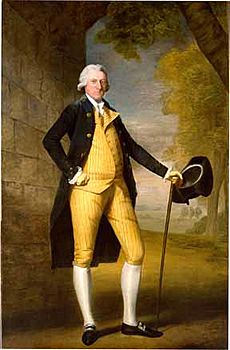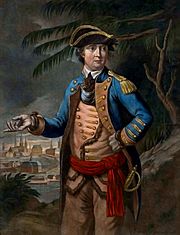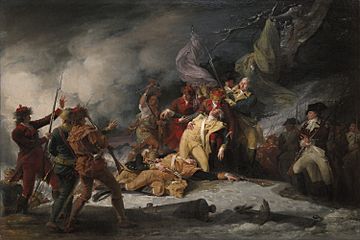Moses Hazen facts for kids
Quick facts for kids
Moses Hazen
|
|
|---|---|
| Born | June 1, 1733 Haverhill, Province of Massachusetts Bay |
| Died | February 5, 1803 (aged 69) Troy, New York |
| Allegiance | |
| Service/ |
|
| Years of service | Provincial militia: 1755–1757 British Army: 1758–1763 Continental Army: 1775–1783 |
| Rank | Brigadier General |
| Unit | Rogers' Rangers 44th Regiment of Foot 2nd Canadian Regiment |
| Commands held | 2nd Canadian Regiment |
| Battles/wars | |
| Signature | |
Moses Hazen (born June 1, 1733 – died February 5, 1803) was an important military leader. He became a brigadier general in the Continental Army during the American Revolutionary War. Born in Massachusetts, he first served in the French and Indian War with a group called Rogers' Rangers.
Hazen was involved in tough actions during the war. He also fought in the 1759 Battle of Quebec. After that war, he joined the British Army and later retired near Montreal, Quebec. There, he and another officer, Gabriel Christie, bought a lot of land together.
In 1775, Hazen joined the American side during their invasion of Quebec. He fought with the Continental Army in the 1775 Battle of Quebec. He then led his own group, the 2nd Canadian Regiment, throughout the war. His regiment fought in the 1777 Philadelphia campaign and at Yorktown in 1781.
Contents
Early Life and Family Background
Moses Hazen was born in Haverhill, a town on the edge of the Province of Massachusetts Bay. His family was an old New England Puritan family. Some historical writings have suggested Hazen was Jewish. However, a family historian found that Hazen's family came from England. Some people at the time thought he was Jewish. For example, a soldier named Sergeant James Thompson wrote in his diary about meeting Hazen. He described him as "a Captain Moses Hazen, a jew."
Serving in the French and Indian War
When the French and Indian War started, Hazen was learning to be a tanner. In 1756, he joined the local army group called the militia. Many of his family members were also in this group. He first served at Fort William Henry near Lake George. There, he likely met Robert Rogers, who led Rogers' Rangers.
Rogers later suggested Hazen become an officer in a new company of the Rangers. In 1758, Hazen became a first lieutenant. He fought at Louisbourg, where the fighting was very intense.
After Louisbourg, his company moved to Saint John, New Brunswick and then Fort St. Anne. They were part of a campaign against Native Americans and Acadians. These actions were sometimes very harsh.
In January 1759, Hazen took command of his company after his captain died. Later that year, his company was at the siege of Quebec. They mostly scouted and raided in the countryside. He was away on a raid during the Battle of the Plains of Abraham.
Hazen also fought in the 1760 Battle of Sainte-Foy. He was badly wounded in the leg during this battle. Because of his injury, he missed the final British campaign that led to the capture of Montreal later that year. In 1761, he bought a position as a first lieutenant in the 44th Regiment of Foot in the British Army. He spent the rest of the war on duty in Montreal. He retired in 1763 with half-pay. General James Murray praised Hazen in 1761. He said Hazen showed "bravery and good conduct."
Land Ventures and Business

During the siege of Quebec, Hazen met Gabriel Christie. Christie was a supply officer and owned land near Montreal. He wanted to buy more land. After the war, Christie and Hazen bought land together. They purchased areas called Sabrevois and Bleury. These lands were on the east side of the Richelieu River near Fort Saint-Jean. They also rented land on the west side of the river. This gave them control over most of the land around Saint-Jean. This area was important because it was the farthest point boats could travel from Lake Champlain.
Christie was often away because of his military service. So, Hazen managed the land development, and Christie provided the money. Hazen built a large house and two mills. He also started businesses selling timber. In 1765, Hazen became a deputy land surveyor and a justice of the peace. He offered General Thomas Gage, who led British forces in New York City, lumber and facilities for military use.
Hazen expanded the businesses, but his quick development also created debts. This caused problems with Christie. In 1770, Christie asked for a financial report because he was unhappy about the debts. This led to them dividing their land. Hazen received the southern part of the Bleury land. Hazen and Christie had many court cases over these lands for years. Christie eventually gained full control after the American Revolution.
In 1762, Hazen's brother John settled Haverhill, New Hampshire. In 1764, Jacob Bayley settled Newbury in what is now Vermont. Hazen owned parts of both these settlements. He also bought land in what is now Bradford, Vermont. Around this time, people first thought about building a road from there to Saint-Jean. This idea came up again during the American Revolutionary War. George Washington later approved building what became known as the Bayley Hazen Military Road.
In 1764, Hazen also joined the Saint John River Society. This group of military officers wanted to develop land along the Saint John River. Other investors included Thomas Gage and Thomas Hutchinson.
In the fall of 1770, Hazen married Charlotte de la Saussaye. She came from a good family in Montreal. They settled near Saint-Jean, built a house, and started farming.
American Revolutionary War Service
Joining the Continental Army
At the start of the American Revolutionary War in 1775, Hazen was living near Saint-Jean. He was retired on half-pay. When Benedict Arnold attacked Fort Saint-Jean on May 18, Hazen reported the news. He told military leaders in Montreal and then Governor Guy Carleton in Quebec. Then he went home to think about how the war might affect him.
The American invasion of Quebec reached his home on September 6. Hazen met with General Philip Schuyler. He told Schuyler that Fort Saint-Jean was well-defended. He also said that local French-Canadians were unlikely to help the Americans. This made Schuyler think about retreating. But more American troops arrived. Also, James Livingston, a local merchant, gave a more hopeful report. This encouraged the Americans to continue their attack. Livingston later formed the 1st Canadian Regiment in November 1775.
Captured and Released
On September 17, Brigadier General Richard Montgomery began to besiege Fort St. Jean. The next day, American troops arrested Hazen north of the fort. However, British soldiers from the fort attacked, forcing the Americans to retreat. Hazen ended up in British hands. Major Charles Preston, the British commander, did not trust Hazen. He sent Hazen to Montreal under guard. Brigadier General Richard Prescott was unhappy with Hazen's explanations and put him in prison.
Hazen was held in bad conditions for 54 days. After Fort St. Jean fell, the British left Montreal. They moved prisoners on ships. Most of these British ships were captured by the Americans. The Americans released Hazen and other political prisoners who had supported them. Hazen was unhappy with how the British treated him. So, he joined the American forces heading to Quebec City. He did this even though the Americans had damaged his property during the siege. They had taken supplies and used his house as a barracks.
Serving in Quebec
Hazen fought in the Battle of Quebec. He was one of two men sent to report the big loss to the Second Continental Congress in Philadelphia. The Congress honored Hazen for his efforts. They made him a colonel leading the Continental Army's 2nd Canadian Regiment. This regiment was often called "Hazen's" or "Congress' Own." This was because Congress created it, and it was not part of any state's army. Hazen was first offered a position as brigadier general. But he refused. He asked for a colonel's position instead. He also asked for payment for losses caused by the war. His property had already been badly damaged by American actions near St. Jean.
Hazen and his second-in-command returned to Quebec. Hazen was stationed in Montreal. He was briefly in charge of Montreal's defenses for the Americans. This was from late March to mid-April 1776. During this time, Hazen sent troops to fortify an area called The Cedars. These forces later surrendered to British and Native American troops during the Battle of The Cedars in May.
Disagreements with Arnold

After Benedict Arnold took command in Montreal, Hazen's regiment was sent to Fort Chambly. Hazen and his men were called to help with the American response at The Cedars. Hazen and Arnold had a heated argument about what to do. Arnold thought Hazen was almost disobeying orders. Arnold had once thought highly of Hazen. He had written that Hazen was "a sensible, judicious officer."
During the American retreat from Quebec in 1776, Hazen and Arnold had a big dispute. This led to charges and counter-charges, and court cases that lasted until 1779. The problem was about supplies that Arnold had ordered taken from Montreal merchants. These supplies were sent to Chambly to be moved south. Hazen was in charge at Chambly. He refused to sign for the goods. He knew they belonged to his friends in Montreal. During the retreat, most of these goods were lost. Arnold wanted to immediately put Hazen on trial for not following orders. But the arriving British army delayed this until the army returned to Fort Ticonderoga.
Hazen's court-martial was held on July 19, 1776. He was found innocent. However, there were problems with the trial. Arnold continued to attack Hazen afterward. In December 1776, another investigation was held. Hazen was again cleared of any wrongdoing. Hazen then accused Arnold of taking goods from the Montreal merchants. Arnold was not cleared of these charges until a higher investigation in 1777.
Building His Regiment
Hazen's regiment became much smaller after the retreat from Quebec. It was sent to Ticonderoga, then to Albany. Hazen kept recruiting new soldiers. Congress allowed him to recruit anywhere in the United States. He had trouble in the northern states. Other recruiters often offered more money. His second-in-command had more success recruiting in the central states. By June 1777, the regiment had about 700 members. The original soldiers from Quebec and the new recruits from the Thirteen Colonies often had disagreements. Hazen kept the French-speaking soldiers in separate companies from the English-speaking ones.
Hazen also asked Congress for money for the damage to his property in Quebec. He asked for $11,363. Congress paid him $2,595 in October 1776.
Fighting in the Philadelphia Campaign
In May 1777, Hazen's regiment joined the main army at Princeton. They were active in the Philadelphia campaign. Some of Hazen's companies fought in the Battle of Staten Island. Hazen's command during the Battle of Brandywine was on the right side of the American line. This position was attacked by the British. Hazen reported early that British troops were on the American side. This turned out to be the main British attack. General Sullivan dismissed Hazen's report. He wrote that "Colo. Hazen's Information must be wrong." Unfortunately for Sullivan, the other reports were wrong, and Hazen's was correct. The British attack from the side helped them win the battle. Hazen's regiment lost 4 officers and 73 men in the battle.
In the Battle of Germantown, Hazen led a group of regiments. They were part of Sullivan's column when it marched on the town. His regiment lost 3 officers and 19 men in this fight.
The Bayley-Hazen Road Project
Since returning to the United States in 1776, Hazen had often written to Congress about Canada. In January 1778, plans began for an invasion of Canada with French help. Hazen was given the job of deputy quartermaster for this operation. However, the planning had problems with supplies and staff. The invasion never started and was canceled by Congress in March 1778.
This failure did not stop Hazen from suggesting a new way to invade Canada. This route went from Newbury, where Hazen owned land, to Saint Francis, Quebec. On July 12, Hazen left Newbury to scout the route. The effort was stopped for a while because soldiers were needed in the New York area. Plans for attacks on Quebec from the Newbury area were thought about again in the fall of 1778. But Washington continued to resist the idea.
Building the Road
In the spring and summer of 1779, Hazen's regiment worked on building the Bayley Hazen Military Road. The goal was still to launch an invasion. Part of the road had been built in 1776 by Jacob Bayley. Hazen oversaw the building of the road up to what is now called Hazens Notch in northern Vermont. Work on the road stopped in August. This was because news came that the British were preparing to capture the construction crew. General Washington had never planned to send an invasion along this route. The whole project was a trick to distract the British. Washington wrote to Congress that the work "was for the purpose of exciting jealousies at Quebec... and of making a diversion in favor of the late expedition under general Sullivan ... this very happily succeeded."
Service Around New York
Hazen and his regiment spent the winter at Washington's main camp in Morristown, New Jersey. Hazen was again involved in legal disagreements. He was not allowed to serve on a court-martial for Benedict Arnold because of their past problems. He also complained about how supplies were managed during the summer's road-building. A review of the army in 1780 suggested that Hazen's and another regiment should be combined. Hazen ended up in command of the combined regiment.
In January 1780, Hazen's regiment was part of a failed attack on Staten Island. News of the plan reached the British. Hazen's regiment was then moved to another group of soldiers. Hazen was given command of this entire group. However, his requests to be promoted to brigadier general were denied many times. During the summer, his group moved to the West Point area. On the way, Hazen let his men stop for water, which broke the army's marching line. A general ordered Hazen's arrest for this. Hazen was found innocent. He then accused the general of bad behavior. The general apologized.
Hazen's regiment was stationed near West Point that fall. This was when British Major John André was captured and General Arnold left the American side. One hundred of Hazen's men, including his nephew, saw André's hanging.

On June 29, 1781, Hazen was finally promoted to brigadier general. He was given command of a group of soldiers under Lafayette during the siege of Yorktown. Hazen's group served on the right side of the line. They were deeply involved in the battles for the redoubts on October 14.
After the British surrendered, Hazen and his unit guarded prisoners at Lancaster, Pennsylvania. While there, a difficult international situation happened. It was called the "Asgill Affair." This situation threatened the peace treaty between the new U.S. and Britain. After some difficult events involving prisoners, Washington ordered Hazen to carry out an order. On May 27, 1782, Hazen followed Washington's order. A British captain was chosen by drawing lots. This choice was against the rules of the Yorktown surrender. The situation of the British captain caught the attention of Queen Marie Antoinette. Washington received a letter from the French Foreign Minister, making it clear that this action would not be acceptable to the French King and Queen. Because of this, the British captain was released in November 1782.
During the winter of 1781–82, Hazen also took time for his personal business. He partnered with another officer to buy land along the military road they had built in Vermont.
Life After the War
After the war, General Hazen could not return to Quebec. He received a grant of land in northern New York. For many years, he worked to help the men who served under him and their families. This was especially true for those who came from Quebec. He helped them try to get payment for their losses. Hazen was also an early member of the Rhode Island Society of the Cincinnati. He continued to be involved in legal cases until his death. He died in 1803 in Troy, New York, where he was buried. His nephew, Benjamin Mooers, eventually helped sort out many of Hazen's affairs.
On May 26, 1828, Congress approved a payment of $3,998.81 to Hazen's family. This was to make up for the half-pay he lost when he joined the American forces.
Legacy
- The Bayley Hazen Military Road is named after him.
- Hazen's Notch in the Green Mountains of northern Vermont is named after him.
- Hazen Union School in Hardwick, Vermont is named after him.




